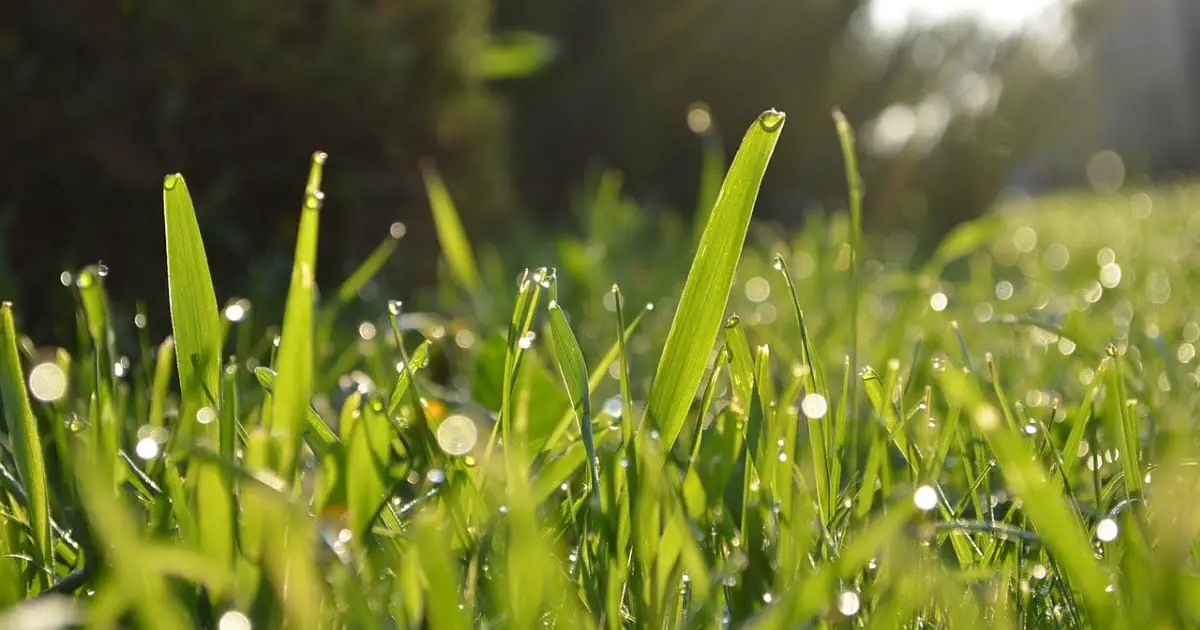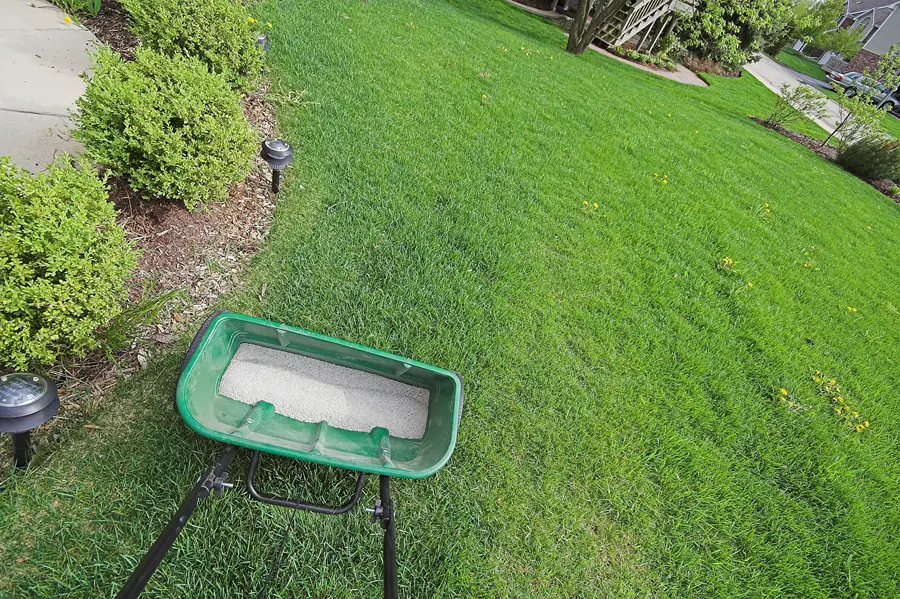What Happens If I Put Too Much Fertilizer On My Lawn
fertilizerlawnsgrassfertilizergrassMany
If you spill fertilizer or realize you over-applied, remove as much excess fertilizer as possible from the soil surface then water the area heavily. This helps rinse any remaining excess from grass or plant leaves and flushes salts through the soil and away from plants.
Furthermore, what happens if I over fertilize? Soluble Salts Linger Behind & Can Cause Root BurnOver–fertilizing can cause detrimental damage to your turf’s root structure as well. Some fertilizers contain high levels of nitrogen, which if absorbed in large amounts can become harmful.
Regarding this, will over fertilized grass grow back?
Healthy grass can bounce back with the right care. You’ll want to make sure the grass is still alive before attempting to revive it. Usually, yellow and brown streaks can recover.
Is it bad to fertilize too much?
Fertilizer is generally made up of nitrogen, phosphorus and nitrogen. If you use too much fertilizer with these nutrients, you can cause burning to new plants, existing flowers and your lawn.
Why Use Lawn Fertiliser
Most lawns will grow fairly well in the UK without needing the application of a lawn fertiliser. However, if you want to improve the general health and appearance of your lawn, using a fertiliser can be a good way to ensure your grass gets the nutrients it needs to stay healthy, green and lush. Proper use of lawn fertiliser can keep your lawn in good condition and will encourage strong, dense grass growth. Not only does lawn fertiliser improve the appearance of your lawn but it can also help your turf to recover from wear and tear and the effects of any harsh weather conditions. Keeping your turf well fertilised with a balanced nutrient programme can also stop your lawn from becoming weak, patchy and thin which can make the grass more susceptible to moss and weeds. Lawns in poor conditions are also more likely to be affected by diseases.
How Many Times Can I Fertilize My Lawn
lawnsfertilizergrassfertilizergrassfertilizegrass
“As the grass grows, it uses more nutrients.” If you have an automatic sprinkler system, you should fertilize your lawn about every six weeks. Without a sprinkler system, you can wait an additional two weeks between feedings.
what happens if you fertilize your lawn too early? If you feed too early in spring the nitrogen likely promotes rapid growth of cool-season weeds. You don’t want that. If you fertilize too late in fall, the grass is likely to be less hardy as it enters cold weather and more susceptible to winter injury.
Beside above, can you over fertilize your lawn?
Yes, you have damaged your lawn, but all is not lost. When you kill or damage your grass with fertilizer, also known as fertilizer burn, you need to find ways to leach the excess fertilizer out of the ground and then reseed the damaged patches.
How often should you fertilize your lawn with Scotts?
Just like we need more nutrients than water can provide to survive, so does your lawn. Feeding your lawn 4 times a year with a product like Scotts® Turf Builder® Lawn Food helps it stay green and grow thick. Maintaining a thick, lush lawn helps prevent weed seeds from sprouting and moving in.
Don’t Miss: Get Rid Of Creeping Charlie Naturally
What Happens When I Put Too Much Fertilizer On The Grass
21 September, 2017
The nutrients included in fertilizer — generally nitrogen, phosphorus and potassium, but sometimes including added benefits like calcium — are sometimes the key to getting your lawn to sprout healthy and bright green as the spring turns into summer. However, overfertilizing grass can lead to serious damage that will ruin the look and feel of your lawn instead of promoting optimal health.
Apply Your Fertilizer When Grass Is Growing

No matter how frequently you fertilize your lawn, the rule of thumb you should follow is that you should apply fertilizer while your grass is growing the fastest.
Over applying fertilizer runs a big risk to your yard:
- Its bad for the environment, since runoff pollutes local streams.
- It runs the risk of burning your grass, which is when you sap grass of natural nutrients causing it to brown.
- Lastly, youre wasting money by buying too much fertilizer.
Recommended Reading: Getting Rid Of Wild Violets
Help For Fertilizer Burn In Lawn Grass
I put fertilizer on my lawn, and a few days later I had patches of dead grass! Will I have to replant, or will the grass come back? Roger
Over fertilizing is one of the quickest ways to kill your lawn. From general discoloration to those telltale stripes from overlapping spreader rows, excessive or careless fertilizing can cause quite a bit of damage to lawn grasses.
How Often You Should Apply Fertilizer To Your Lawn
Though fertilizer has its benefits, you dont want to overdo it. A full feeding is recommended at least 5-6 times per year. You want to feed your lawn when its growing most rapidly. However, you should base the frequency on your climate and the type of grass you have. For example, cool season grasses can be fertilized in late spring, but only if necessary.
Warm season grasses, like Bermuda grass, St. Augustine, zoysia, centipede and buffalo grass, should be fertilized in spring. Depending on the amount of water your grass gets, aim to reapply your fertilizer every 6-8 weeks. Keep a watchful eye on your grass. If it looks thick and green, you can probably skip the feeding. If its starting to look brown or black, give your lawn some TLC.
Recommended Reading: What Is Peat Moss Used For On Lawns
When Should I Fertilize My Lawn In Spring And Fall
As well as knowing how often to apply fertilizer, its also key to know when to apply the fertilizer. To answer this question, it is recommended that you should always follow the instructions found on the label of your chosen fertilizer. However, following the general tips below will help you decide when to fertilize the lawn:
- Apply when the grass is actively growing.
- Apply when the soil is damp and the grass is dry.
- Apply when the grass is frost-free.
- Dont mow the lawn 3 days before or after applying the fertilizer.
Applying fertilizer outside of the period stated on the instructions as well as the guide above will run the risk of damaging your lawn so it is important to pay attention to this.
Dont apply fertilizers to your lawn during the winter months as the grass is dormant and will not achieve any better results. Applying fertilizer in the winter will increase the chance of polluting waterways by excessive run-off of the nutrients into nearby streams.
What Happens When You Over Fertilize A Lawn
you over fertilizegrassfertilizerFertilizerlawn
Will over fertilized grass grow back?
Healthy grass can bounce back with the right care. Youll want to make sure the grass is still alive before attempting to revive it. Usually, yellow and brown streaks can recover.
Can you put too much nitrogen on your lawn?Too much nitrogencanthegrassThe grasstooToo much nitrogen canthe lawn grassExcess nitrogen canthe
Contents
Don’t Miss: Can You Spray Your Lawn For Ticks
Cutting Grass Too Short
If mowing isn’t your idea of weekend fun, you might be tempted to skip a round or two by cutting the grass extra short.
And while cutting the grass shorter may save you from mowing so often, it ends up starving the plant, as sunlight is collected via the leaves. Hello, brown lawn.
“Grass should never be cut lower than two and a half to three inches,” says Granat.
When Should You Water Your Lawn After Fertilizing And For How Long
Some rules are just made for following.Always stop at a kids lemonade stand.Water after fertilizing your lawn. The lemonade thing is easy.But when exactly do you water after fertilizing? And for how long?Whether you apply your own fertilizer or hire a lawn care company to do it, heres the deal with watering after fertilizing your lawn.
Recommended Reading: Thistledown Weed Killer
How To Repair Burned Grass From Fertilizer
Burned lawns will need a generous amount of water to get back to green. Its important to water your lawn as soon as you spot any brown or yellow patches to prevent further damage. Slowly soak the affected areas every day for about a week to fully flush out the salt. And, keep in mind the best time to water is in the morning!
Check back in on your lawn in a few weeks. The affected areas should be turning green. If not, those areas of your lawn may need to be dug up and over seeded.
And next time, use a slow-release fertilizer to reduce the risk of fertilizer burnand follow the instructions to a T. Or ensure you get it right by clicking below and having the experts handle it!
What Month Should I Fertilize My Lawn

Most lawn care companies recommend that you apply lawn fertilizer in the spring, between February and April. This is when your grass will start to green up as it begins to actively grow. Basically, if it looks like your grass is ready for its first mowing of the season, then it should also be ready for lawn fertilizer.
While most people know to fertilize their lawns in the spring, it is important to remember that fall feeding is critical, too. In the fall, grass roots are going down into the soil and need fertilizer to stay healthy. This is the most important application of fertilizer for the whole year since it will protect your lawn as it goes dormant over winter. However, if the fall you should use a specific fall fertilizer that is slightly higher in phosphorous and potassium, as it will promote better root growth. To ensure optimal lawn health, fertilize heavily in the fall and lightly in early spring.
Don’t Miss: How To Get Rid Of Wild Violets In Your Lawn
Be Careful Not To Spread Too Much Fertilizer On Lawn
BIOG:NAME:UPD: 19970328 -TEXT-
Want to be the envy of your neighbors this spring by boasting the lushest lawn on the block?
Well, take note: Dumping excess fertilizer on your lawn does not necessarily mean greener grass. In fact, putting too much fertilizer on your lawn or garden or putting the wrong kind of fertilizer can do more harm than good.
Beautiful gardens and lawns need to be fertilized – the right way. Using too much fertilizer wastes time and money and may kill some plants and grasses. Excess fertilizing can also affect underground water supplies and lakes.
Excessive nitrogen from fertilizer can leach through soil into groundwater when over application is followed by excessive rainfall or irrigation. Phosphorous from fertilizers may be washed by rainfall into ponds, streams, and lakes, where it encourages the growth of algae and other aquatic weeds.
The first step to a healthy lawn and garden is a soil test. This test will prevent you from guessing how much or the type of fertilizer your soil needs by indicating the pH and nutrients in the soil.
Simply take about 10 samples 4 to 6 inches below the surface where the roots are located and mix them together for a representative sample from the area you want to be tested. Then fill a clean pint container with your soil and submit it to the Okla homa County extension office. Or pick up a soil test kit at your local garden center or library.
Helpful tips when applying fertilizer include:
Archive ID: 677153
How To Treat Fertilizer Injury
If you suspect you may have over fertilized your plants, treat the area as soon as possible. Treat spillage by scooping up as much of the fertilizer as possible. The only thing you can do for over fertilized soil is flush the soil with as much water as it will hold over the next few days.
Dont allow the water to run off. Toxic runoff can contaminate nearby areas and may get into waterways where it causes substantial damage to the environment. Water slowly to allow the water to sink in rather than run off.
Recommended Reading: Killing White Clover In Lawn
More Natural Tips For A Healthy Lawn
- Cut fertilizer amounts in half. Cutting back on feedings may be a hard habit to form but is well worth the effort. The transition should be gradual for best results.
- Leave grass clippings as natural mulch. This will encourage earthworms and improve water penetration and healthy roots.
- Keep mower blades sharp. Set mower blade height 2 1/2″- 3″ in summer.
- Avoid removing more than 1/3 of grass height at a time.
- Water 15 – 20 mins. three times a week in hot seasons instead of five times for 5-10 minutes. Heat stressed spots can be watered by hand or hose-end sprinkler. If penetration is a problem, water until the point of run-off, turn off the sprinklers, let the water soak in, then cycle again 1 hour later. A surfactant can help percolation on hydrophobic soils by breaking the surface tension, and a moisture meter is an essential tool for checking uneven distribution.
- Adjust timers to meet seasonal needs.
- Aerate the lawn every 2 years or when it’s compacted. This should be done at the same time as the first feeding for the specific grass type. Do not aerate dormant turf. Plugs can be left to break down with irrigation.
Can You Put Too Much Lime On Your Lawn
Agricultural lime could be a lifeline for anyone looking to spruce up or revive a lawn that has seen better days.
But can you put too much lime on your lawn? Unknown to many who try this trick, you can have too much of a good thing. Too much lime can limit your lawns access to nutrients, damage your grass, inflict high soil alkalinity disorders, and even turn your grass yellow the last of which was probably the reason you decided to lime your grass in the first place.
So, how will you know if you have applied too much lime? What should you do if you have applied too much lime? Here is your comprehensive guide to the question: can you put too much lime on your lawn?
Recommended Reading: What Is The Best Weed Killer For Creeping Charlie
If You Are Ever In Doubt You Can Go Organic
Organic fertilizers are made from compostable ingredients.
These components are broken down by the microbes in the soil and do not release the same materials which other fertilizers do. Organic fertilizers have less chance of burning your lawn, but they are often more expensive than regular fertilizers. That’s unless you make your own compost.
Replacing Grass With Fertilizer Burn
If you determine your burned turf is beyond repair or isnt responding to your attempts to repair it through watering, youll have to replace it to make your lawn lush again.
Though the process is similar to ripping up any grass and replacing it with new sod, there are a few extra steps to take along the way.
Step 1: Remove the Old Grass
If the affected area is small enough, remove the dead grass by raking it out with a hard rake. If the burned area is too large for manual removal, use a sod cutter to cut up the dead grass, then roll it up like a rug and remove it.
Step 2: Prepare the Soil
Prepare the soil for the new grass by tilling or aerating it to loosen any compacted soil. Once loosened, test the soils nutrient and pH levels with a home soil test from a lawn and garden store. Amend the soil if its short on nutrients or the pH levels arent acceptable.
Level the soil with the backside of a hard rake.
Step 3: Lay the Sod or Reseed
When replacing the grass, you can either lay new sod for an immediate repair or reseed it to reduce cost.
If youre laying sod, simply place the sod on the leveled soil. When you get to the perimeter, use a sod knife to trim the sod pieces to fit. Walk over the newly sodded area and use your feet to stomp down any uneven areas.
Step 4: Water and Wait
When mowing your lawn, avoid the area you laid seeds or sod until the new grass is 3 inches tall or the sod no longer lifts when you pull up on it.
Step 5: Mow and Maintain
Recommended Reading: How To Get Rid Of Rye Grass In Lawn
How Do I Know If My Lawn Needs Nitrogen
Excessive weed growth is often an indication that your lawn is lacking in nitrogen. A reduced number of grass clippings than usual after mowing can also be a sign of nitrogen depletion. The most common symptoms, however, are yellow or yellow-green grass blades, little to no regrowth, and a low grass density. Although seasonal changes may sometimes be the culprit, more likely than not, its a nitrogen deficiency, and therefore fertilizer is required.
Learn From Your Mistakes

Part of being a weekend warrior DIYer is making mistakes and learning as you go. These mistakes can sometimes be costly or time-consuming, but there is always a valuable lesson in them. Burning your lawn with fertilizer is no exception.
Fortunately, you can bring your lawn back to life through nursing it back to health or replacing it. And using the lessons you learned from overfertilizing it last time, you now know what to avoid to ensure your fertilizers helping, not hurting, your lawn.
Need more tips? Check out our beginners guide to fertilization. It provides all the tips any beginner needs to fertilize their lawn like a pro.
Read Also: How Do I Fill In Bare Spots In My Lawn
